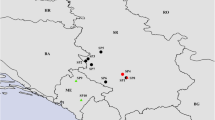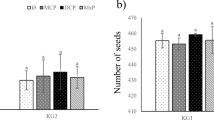Abstract
The content of 19 metals (Al, V, Cr, Co, Ni, Cu, Zn, Ga, Rb, Sr, Zr, Nb, Cs, Ba, Ce, Pb, Th, U and Nd) was investigated in 15 edible species of phylum Basidiomycota collected in an area with quartzite acidic soils in a province of the central Spain. The study explores the differences in metal accumulation in relation to fungal species, and the results were related to metal content in soil through the determination of bioconcentration factors. Regarding the highest concentrations, Zn, Al, Cu and Rb were the metals more accumulated in the sporocarps. Notable concentrations were also found in Sr, Zr, Ba, Cs and Ce. The major bioconcentration factors were found for Cu and Zn in sporocarps of Agaricus silvicola and Lepista nuda. Regarding the different species, Tricholoma equestre and Cantharellus cibarius were those with the greatest capacity to absorb trace elements, and in contrast, Amanita caesarea and Agaricus campestris showed the lowest values. The cluster analysis shows that there are some species with the same nutritive physiology that share similarities in the absorptive behaviour. Lactarius sanguifluus and Lactarius deliciosus, both ectomycorrhizas of the genus Pinus, are closely related, and Clitocybe gibba, L. nuda and Marasmius oreades, all of them saprobes on soil organic matter, are very close too.








Similar content being viewed by others
References
Cocchi L, Vescovi L, Petrini LE, Petrini O (2006) Heavy metals in edible mushrooms in Italy. Food Chem 98:277–284
Falandysz JJ, Kunito T, Kubota R, Gucia M, Mazur A, Falandysz-Jaromir J, Tanabe S (2008) Some mineral constituents of Parasol mushroom (Macrolepiota procera). J Environ Sci and Health B Pestic Food Contam Agric Wastes 43:187–192
Kalac P (2010) Trace element contents in European species of wild growing edible mushrooms: a review for the period 2000–2009. Food Chem 122:2–15
Landeweert R, Hoffland E, Finlay RD, Kuyper TW, van Breemen N (2001) Linking plants to rocks: ectomycorrhizal fungi mobilize nutrients from minerals. Trends Ecol Evol 16:248–254
Gadd GM (2006) Fungi in biogeochemical cycles. Cambridge University Press, Cambridge
Gadd GM (2007) Global biogeochemical cycling: fungi and their role in the biosphere. Encyclopedia of ecology. Elsevier, Amsterdam
Amundson R, Richter DD, Humphreys GS, Jobbágy EG, Gaillardet J (2007) Coupling between biota and earth materials in the critical zone. Elements 3:327–332
Courty PE, Buée M, Diedhiou AG, Frey-Klett P, Le Tacon F, Rineau F, Turpault M-P, Uroz S, Garbaye J (2010) The role of ectomycorrhizal communities in forest ecosystem processes: new perspectives and emerging concepts. Soil Biol Biochem 42:679–698
Meharg AA, Cairney JW (2000) Co-evolution of mycorrhizal symbionts and their host to metal-contaminated environments. Adv Ecol Res 30:69–112
Hoffland E, Kuyper TW, Wallander H, Plassard C, Gorbushina AA, Haselwandter K, Holmströn S, Landeweert R, Lundström US, Rosling A, Sen R, Smits MM, van Hees PAW, van Breemen N (2004) The role of fungi in weathering. Front Ecol Environ 2:258–264
van Schöll L, Kuyper TW, Smits MM, Landeweert R, Hoffland E, van Breemen N (2008) Rock-eating mycorrhizas: their role in plant nutrition and biogeochemical cycles. Plant Soil 303:35–47
Demon A, De Bruin M, Wolterbeek ThH (1988) The influence of pH on trace element uptake by an alga (Scenedesmus pannonicus subsp. Berlin) and fungus (Aureobasidium pullulans). Environ Monit Assess 10:165–173
Ehrlich HL (2002) Geomicrobiology. Marcel Dekker, New York
Gadd GM (2007) Geomycology: biogeochemical transformations of rocks, minerals, metals and radionuclides by fungi, bioweathering and bioremediation. Micol Res 111:3–49
White NA (2004) The importance of wood decay fungi in forest ecosystem. In: Arora DK (ed) Fungal biotech in agric, food, and environ appl. Marcel Dekker, New York
Gadd GM (1993) Interactions of fungi with toxic metals. New Phytol 124:25–60
Ouzouni PK, Veltsistas PG et al (2007) Determination of metal content in wild edible mushroom species from regions of Greece. J Food Comp Anal 20:480–486
Agrahar-Murugkar D, Subbulakshmi G (2005) Nutritional value of edible wild mushrooms collected from the Khasi hills of Meghalaya. Food Chem 89:599–606
Calonge FD, Moreno G, et al (2008) Flora Micológica de Castilla La Mancha. Situación actual y conservación de los hongos del bosque. Memoria Final (2004–2007). Hernandez-Crespo Ed. Real Jardín Botánico CSIC. Madrid
Mino Y, Yukita M (2005) Detection of high levels of bromine in vegetables using X-ray fluorescence spectrometry. J Health Sci 51:365–368
Rudawska M, Leski T (2005) Trace elements in fruiting bodies of ectomycorrhizal fungi growing in Scots pine (Pinus sylvestris L.) stands in Poland. Sci Total Environ 339:103–115
Müller M, Anke M, Illing-Günther H (1997) Aluminium in wild mushrooms and cultivated Agaricus bisporus. Eur Food Res Tech 205:242–247
Vetter J (2005) Mineral composition of basidiomes of Amanita species. Mycol Res 109:746–750
Alonso J, García MA, Pérez-López M, Melgar MJ (2003) The concentrations and bioconcentration factors of copper and zinc in edible mushrooms. Arch Environ Contam Toxicol 44:180–188
Blanusa M, Kucak A, Varnai VM, Saric MM (2001) Uptake of cadmium, copper, iron, manganese, and zinc in mushrooms (Boletaceae) from Croatian forest soil: trace element analysis and occurrence in foodstuffs. J AOAC Int 84:1964–1971
Falandysz JJ, Kunito T, Kubota R, Gucia M, Mazur A, Falandysz-Jaromir J, Tanabe S (2008) Some mineral constituents of Parasol mushroom (Macrolepiota procera). J Environ Sci Health B Pesticides Food Contam Agric Wastes 43:187–192
Mendil D, Uluözlü OD, Hasdemir E, Çaglar A (2004) Determination of trace elements on some wild edible mushroom samples from Kastamonu, Turkey. Food Chem 88:281–285
Soylak M, Saraçoglu S, Tüzen M, Mendil D (2005) Determination of trace metals in mushroom samples from Kayseri, Turkey. Food Chem 92:649–652
Çayir A, Coşkun M, Coşkun M (2010) The heavy metal content of wild edible mushroom samples collected in Canakkale Province, Turkey. Biol Trace Elem Res 134:212–219
Nyholm NEI, Tyler G (2000) Rubidium content of plants, fungi and animals closely reflects potassium and acidity conditions of forest soils. For Ecol Manag 134:89–96
Wallander H (2000) Use of strontium isotopes and foliar K content to estimate weathering of biotite induced by pine seedlings colonised by ectomycorrhizal fungi from two different soils. Plant Soil 222:215–229
Campos JA, Tejera NA, Sánchez CJ (2009) Substrate role in the accumulation of heavy metals in sporocarps of wild fungi. Biometals 22:835–841
Dursum N, Özcan MM et al (2006) Mineral content of 34 species of edible mushrooms growing wild in Turkey. J Sci Food Agric 86:1087–1094
Chudzynski K, Falandysz J (2008) Multivariate analysis of elements content of Larch Bolete (Suillus grevillei) mushroom. Chemosphere 73:1230–1239
Magnuson JK, Lasure LL (2004) Organic acid production by filamentous fungi. In: Tkacz JS, Lange L (eds) Advances in fungal biotechnology for industry, agriculture and medicine. Kluwer Academic, New York
van Hees PAW, Rosling A et al (2006) The biogeochemical impact of ectomycorrhizal conifers on major soil elements (Al, Fe, K and Si). Geoderma 136:364–377
Thompson GW, Medve RJ (1984) Effects of aluminum and manganese on the growth of ectomycorrhizal fungi. Appl Environ Microbiol 48:556–560
Melgar MJ, Alonso J, García MA (2009) Mercury in edible mushrooms and underlying soil: bioconcentration factors and toxicological risk. Sci Total Environ 407:5328–5334
García MA, Alonso J, Melgar MJ (2009) Lead in edible mushrooms levels and bioaccumulation factors. J Hazard Mater 167:777–783
Landeweert R, Hoffland E, Finlay RD, Kuyper TW, van Bremen N (2001) Linking plants to rocks: ectomycorrhizal fungi mobilize nutrients from minerals. Trends Ecol Evol 16:248–254
Acknowledgements
We would like to thank Carlos Rivera from the ITQUIMA—UCLM for his technical support using X-ray fluorescence spectrometer, Carlos Sánchez from Chemistry–Physics Department—UCLM for allowing the measurements, to our students of Agronomic Engineering Faculty of Ciudad Real (ETSIA-CR—UCLM), our friends of the Mycological Society of Saceruela and of AVAN for their invaluable assistance collecting and handling the mushrooms. We also thank sincerely to anonymous reviewers for their effort and time spent reading the paper and making corrections, valuable suggestions and advices.
Author information
Authors and Affiliations
Corresponding author
Rights and permissions
About this article
Cite this article
Campos, J.A., Tejera, N.A. Bioconcentration Factors and Trace Elements Bioaccumulation in Sporocarps of Fungi Collected from Quartzite Acidic Soils. Biol Trace Elem Res 143, 540–554 (2011). https://doi.org/10.1007/s12011-010-8853-4
Received:
Accepted:
Published:
Issue Date:
DOI: https://doi.org/10.1007/s12011-010-8853-4




